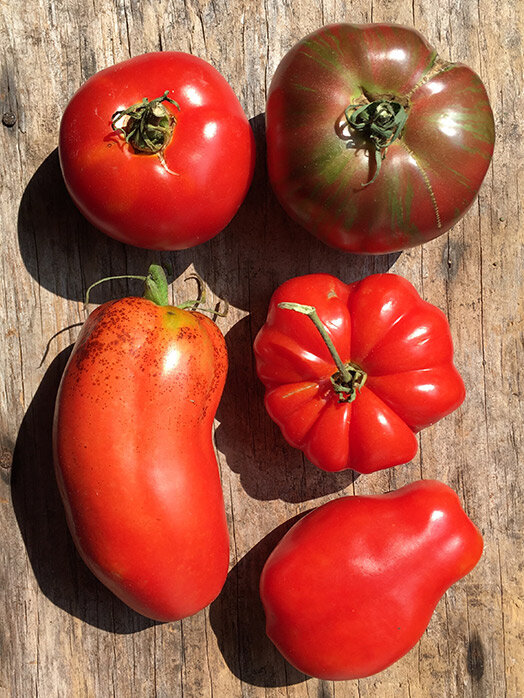Top Tomatoes to GroW
I love, love, love fresh garden tomatoes! Turns out, I’m not the only one—93% of us gardeners in America grow tomatoes. Given that there are over 10,000 varieties of this beloved garden gem, it’s easy to have your head spin at all the possible ones to grow.
Having grown these beloveds for the past two decades, I’m not ashamed to say that I’ve developed favorites over the years. Juliet for example, is probably the one tomato I wax most poetically about. Years and years ago when I lost nearly my entire crop of tomatoes to Late Blight, Juliet was the one variety that hung in there. Prolific, delicious, tenacious…what more could you want from a tomato? As long as I have a garden, I’ll have Juliet in it.
I was instantly smitten with Pink Berkeley Tie-Dye the first time I grew it. It was one of the first to ripen, and when it did, it was a complete stunner of rose pink striped with green streaks. It’s been a garden staple ever since.
Because I am always on the hunt for new varieties to try, I reached out to my garden friends on Instagram to share their favorite tomatoes to grow, and after hundreds of responses, here are the top ten favorites to grow.
1. Sun Golds
2. Pink Berkeley Tie-Dye
3. Brandywine
4. Juliet
5. Kelloggs Breakfast
6. Aunt Ruby’s German Green
7. Indigo Pear Drops
8. Black Krim
9. Black Cherry
10. Cherokee Purple
Clockwise from top right: Pink Berkeley Tie-Dye, Costoluto Fiorentino, San Marzano, Blue Beech, Glacier.
Juliet…if I only could grow one single seed, it would be Juliet.
When selecting which variety will work best for you, decide first what you’re looking for in a tomato.
Tomato varieties fall into three main categories:
Cherry, Slicing and Paste:
CHERRY TOMATOES are little garden delights that can be round, pear or tear-dropped shaped. They tend to be the first tomatoes to ripen and usually are one of the last to go. Their sweet flavor is fabulous in salads, snacks and general noshing.
SLICING TOMATOES are those ones we all dream about over long winter’s days—the big, round, meaty tomatoes that are phenomenal not only as sandwich toppers, but just on their own with a sprinkling of salt and a splash of balsamic vinegar.
PASTE TOMATOES are the ones I tend to grow most of because their thick, meaty flesh has a low water content that makes them ideal for sauces and canning. Many of these varieties tend to be determinate, which means that its fruits ripen at the same time, allowing you to plan for processing big harvests.
Is your variety Determinate or Indeterminate:
DETERMINATE TOMATOES grow to a certain height, making them shorter and bushier. Their fruits also ripen together at a similar time, making it a great choice for folks who want to process their harvests in big batches. Because of their limited growth, determinate tomatoes tend not to need pruning.
INDETERMINATE TOMATOES grow vines and flowers all season long until frost. They also produce fruit along the way. Because these tomatoes grow and grow, they must be trellised to help maintain not only their manageability, but to help ward off disease as well. A quick fun fact, according to Guinness World Record, the tallest tomato ever grown clocked in at 65ft! Imagining trying to harvest from that plant. Because indeterminate varieties create a lot of foliage, it is smart to keep the suckers pruned to allow for better air circulation.
Here are a few tips for starting your tomato babies off right:
• Start seeds indoors 6-8 weeks before last frost date
• Tomato seeds will germinate in 7-14 days
• Once germinated, move seedlings under lights in a room with a temperature of 70ºF. Keep seedlings under the lights for 14 hours a day. (If you have windows that get great full sun exposure, you can keep your seedlings on the sill.)
• When your seedlings develop their first set of true leaves, pot up into 3” pots
Here are a few other tips for when it comes time to plant your tomatoes outside:
• Once the evening temperatures regularly stay above 50ºF, it’s time to transplant your tomato seedlings out into the garden. This often is around 2-3 weeks after last frost date.
• Prior to transplanting, make sure to harden off your seedlings. To do so, start by placing your tomato seedlings in a well protected spot and slowly expose seedlings to direct outside sunlight for a few hours each day. Over the course of a week or two, increase the amount of time outside.
• Tomatoes need a solid 8 full hours of sun a day
• Like well-drained soil with a pH between 6.0-7.0
• Dig a 12” deep hole to plant seedling. In the bottom of the hole, toss in a handful or two of well-aged compost, plus a sprinkling of bone meal. Both help promote healthy plants and early ripening.
• Tomato Fun Fact: Did you know that all those tiny hairs that grow along the tomato’s stem can actually turn into roots once planted in the ground? Because of this, you’re able to transplant your tomatoes fairly deeply into the ground. So anyone with leggy seedlings, this many give you a much needed reprieve.
• Tomatoes are 95% water, so they need good, consistent watering in order to provide happy bounties, so make sure to give each plant a good 1”-2” of water a week. Avoid fungal and bacterial disease by watering at base of plant, rather than from above.
• COMPANION PLANT with Basil, Borage, Chives, Garlic, Mint, Nasturtium & Parsley. Keep plants away from Brassicas (cabbage, broccoli, cauliflower, etc…), Corn, Dill and Potatoes. Click HERE for more companion plant partners!






